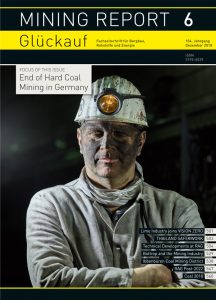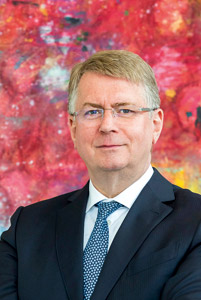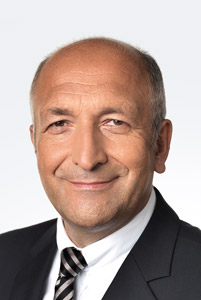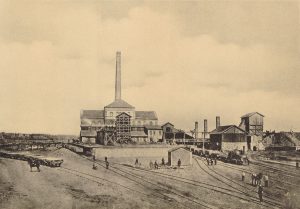At the end of December 2018 Germany’s last two remaining coal mines, namely Prosper-Haniel colliery in the Ruhr district and Ibbenbüren colliery further north in Münsterland, will close down forever in line with government policy. This will mark the final chapter in an industrial history dating back more than 200 years. It also provides a fitting opportunity for Mining Report Glückauf to dedicate this issue to this special occasion.
Read moreWith my best regards // Mit freundlichem Glückauf
Dipl.-Ing. Andreas-Peter Sitte
Chief Editor Mining Report Glückauf, Essen
Greetings of RAG-Stiftung
Greetings of RAG-Stiftung
The German coal mining industry, whose history goes back some 200 years, will cease to exist at the end of December 2018. But for the German coalfield communities this end also heralds a new beginning and the start of a new “post-mining” era. The RAG Foundation was established on the basis of, and as part of, the 2007 coal-policy agreement that provided for the closure of the subsidised coal industry. Its remit has been to ensure proper corporate management of the process by which the RAG-operated coal industry is shut down in a socially responsible way and at the same time to put the former “white part” of RAG on an independent footing – this resulting in the creation of Evonik Industries, now a global player in the speciality chemicals market. The capital-market and investment income accruing from these business activities is to be used to build up a private-sector foundation fund. The latter will in future serve to finance the eternity burdens inherited from the coal mining industry, such as mine dewatering, polder drainage measures and ground-water treatment, without placing a burden on the public budget. The operational activities will be taken over by a post-mining RAG, which will also use its reserves for financing the orderly closure of the last active collieries and the inherited liabilities remaining from the non-active mining industry, such as surface subsidence, shaft repair and stabilisation and site remediation. The RAG Foundation will also be supporting education, science and culture in the mining regions insofar as this is associated with the mining industry. In addition to the many projects connected with the “Glückauf Zukunft!” initiative that has been launched to mark the final passage of the coal mining industry this will also include funding for the German Mining Museum in Bochum, which will stand as a cultural tribute to the German coal industry, and for the Georg Agricola University of Applied Sciences, with its Research Centre Post-Mining. All these various activities will continue to require scientific support and guidance and, ideally, access to a professional journal as a forum for presenting academic work of this kind. This has always been the function of industry stalwart Mining Report Glückauf, a mining magazine with a rich tradition and a reputation that extends far beyond the borders of Germany. It is a role that is set to continue well after the end of 2018.
Bernd Tönjes
Chairman of the Executive Board
RAG-Stiftung, Essen
Greetings of RAG Aktiengesellschaft
Greetings of RAG Aktiengesellschaft
A momentous chapter in Germany’s industrial past will finally be brought to a close in December of this year when coal mining finally comes to an end after a history dating back some 200 years. This will be a watershed moment for the country at large and the coalfield communities – and perhaps most of all for RAG and its workforce. Since its founding fifty years ago the company has had countless challenges to face, with the socially-responsible rundown of the mining industry probable being the hardest of all. It was a task that the management team completed successfully: the agreed production targets were achieved without fuss or quibble and the industry showed unfailing commitment in its contribution to national energy security.
Our mineworkers have proved their skills time and time again under the most difficult of circumstances. The geological conditions present in Germany’s coalfields have forced the continued development of technical equipment and organisational methods. These advances were not entirely attributable to the increasing depth of the mine workings, circumstances that placed extreme demands on men and machinery and created unrelenting cost pressures. Over the years the growing awareness of the need to protect man and the environment has also helped establish significant technical and organisational improvements within the coal industry, particular in its underground operations.
It was for this very reason that the Mining Report Glückauf reached the logical conclusion that by creating a partnership with the mining section of the International Social Security Association – ISSA Mining – it could provide a regular platform in each issue for highlighting the national and international efforts being made in the field of occupational health and safety. In our view this work is a crucial factor in developing a modern and sustainable mining industry.
Over its lifetime the Mining Report Glückauf has supported these endeavours and has served as a communication platform for sharing ideas on technical developments and progress achieved. The close ties that developed over the years between the magazine and the German mining sector meant that the coal industry always featured large in the journal’s content. And finally, in line with matters of topical interest to RAG there has also been a regular stream of papers dealing with the post-mining theme. This has inevitably become a subject of increasing relevance for the coalfield communities and will be one of RAG’s central tasks from 2019 on. In view of the challenges that lie ahead for RAG there is therefore every prospect that this close partnership will continue along successful lines in the coming years, though with a somewhat different focus.
The pool of topics is unlikely to run dry.
Peter Schrimpf
Chairman of the Executive Board
RAG Aktiengesellschaft, Essen
Greetings of the Gesamtverband Steinkohle
Greetings of the Gesamtverband Steinkohle
Dr. Jürgen-Johann Rupp
Chairman of the Executive Board (President) of the German Coal Association (GVSt), Essen, and Member of the Executive Board
of RAG Aktiengesellschaft, Essen
When the Board of the German Coal Association (GVSt) resolved in 2014 that the Association should take over the editorship of the technical journal Mining Report Glückauf it was a decision based on two key aims. Firstly, this specialist publication with its strong historical links should continue to serve as a platform for scientific exchange and at the very least up to the end-date for German coal production. This objective has been achieved, as you can see from this latest edition of the magazine, now in its 154th year, which you are holding in your hands. Over the last four years authors from the RAG Group have used the Mining Report as a forum for their various reports and papers covering technology, corporate organisation, occupational safety and, increasingly, the particular theme of the post-mining era.
At the same time the Association took on the task of developing the magazine – which has been so influenced by the coal industry over the years – in such a way as to establish a clear thematic and commercial perspective beyond 2018.
We have now embarked on this path. While keeping with the printed issues for the moment we shall also be using campus licences to make the digital editions available to universities and students. Retaining the bi-lingual format throughout will emphasise the international aspirations of the magazine – with a special focus on the European market. As well as covering the post-mining themes that have emerged from the active years of the coal mining industry we have made it our objective to establish Mining Report Glückauf as a leading European publication with a high academic standing.
In this regard it is most important that we monitor the existing scientific quality of the magazine by way of a formal quality assurance process. It is therefore proposed, from the beginning of 2019, to instigate a peer review process in line with the highest scientific standards. As no comparable system yet exists within the European mining sector it is to be hoped that closing this loophole will also help establish the magazine as a successful international publication. In the past we have always been able to count on the advice and support of the mining universities and I am optimistic that they will join us in taking this important step forwards.
The GVSt will now step back from its commercial responsibility for Mining Report Glückauf, though will continue to maintain a watching brief on the magazine content. The groundwork has now been laid for a successful start to a new era in what will be the 155th year of this historically significant publication.
So may I wish success and good luck to one and all.
Dr. Jürgen-Johann Rupp
Chairman of the Executive Board (President) of the German Coal Association (GVSt), Essen, and Member of the Executive Board
of RAG Aktiengesellschaft, Essen
Company Greetings
Company Greetings
Greetings to the end of hard coal mining in Germany (german language only) read more
Documentation of Technical Developments at RAG on Examples taken from Coal Winning, Development Works and Logistics
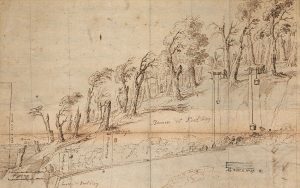
Fig. 2. Oranian map (about 1650) – Layout plan “Buchholz”. // Bild 2. Oranische Karte (um 1650) – Grubenriss Buchholz. Source/Quelle: RAG Anthrazit
Authors: Dipl.-Ing. Detlef Imgenberg, Dipl.-Ing. Michael Lemke, Prof. Dr.-Ing. Martin Junker, RAG Aktiengesellschaft, Essen
Read moreA Success Story: Bottrop and the Mining Industry
On 15th December 2016 the Prosper-Haniel roadway drivage team completed the last of Bottrop colliery’s development projects with the final breakthrough into the Haniel-West panel on the 1,240 m level. This would provide access to all the remaining coal that was to be extracted before the mine was finally closed for ever. Prosper-Haniel colliery, with its 1,400-strong workforce, is on course to achieve its target output of 1.9 mt before the mine ceases production at the end of 2018. This is in line with the provisions of the Coal Industry Financing Act requiring the German coal industry to shut down its operations this year. The end of coal mining will bring with it profound changes – not just for the mineworkers but for the entire region. Coal mining in Bottrop can look back over a 160-year history marked by economic dynamism and, more particularly, by technical innovations…Author: Dipl.-Ing. Jürgen Kroker, Bergwerksdirektor Bergwerk Prosper-Haniel, RAG Aktiengesellschaft, Essen
Read moreLast Shift for the Mine in the deep North – the Ibbenbüren Coal Mining District looks back on nearly 500 Years of History
With the hoisting of the last skip on 4th December 2018, the last chapter of hard coal production at the mine of RAG Anthrazit Ibbenbüren GmbH, Ibbenbüren/Germany, ended, and thus by the end of 2018 the hard coal mining in Germany. Despite all the melancholy, the team has been highly motivated to the last moment and has done his job reliably. All mining objectives were reached ahead of time, the last coal was mined on 17th August 2018. Ibbenbüren coal mining has an extraordinarily long and varied history. Faced with exceptional geological challenges, and in crisis situations, often threatened by closure, the Ibbenbüren miners often performed astonishing pioneering feats in the field of mining. Till today a state-of-the-art coal mine has produced hard coal in Ibbenbüren. This mine has often been a pioneer in the German hard coal mining industry with its numerous technical developments and innovations.
Author: Dr.-Ing. Heinz-Werner Voß, Sprecher der Geschäftsführung, RAG Anthrazit Ibbenbüren GmbH, Ibbenbüren
Read moreRAG post-2022
The RAG company, which is based in Essen/Germany, has always been known as a coal producing business. However, following the coal-policy decisions taken in 2007 and 2010 this era is set to come to a close at the end 2018 after more than 150 years of coal production in the Ruhr Basin and an even longer history of mining in the Saar and Ibbenbüren areas. This paper describes the services that RAG will still have to provide after 2018 and in addition explains how the company will be constituted and what has been done to prepare for these fundamental changes.
Authors: Dr.-Ing. Gunter Hagen, Leiter Konzernentwicklung/QUADRO-Zentrum, Dipl.-Ing. Stefan Hager, Direktor Servicebereich Standort- und Geodienste, RAG Aktiengesellschaft, Essen
Read moreCoal 2018 – the Annual Report of the German Coal Association
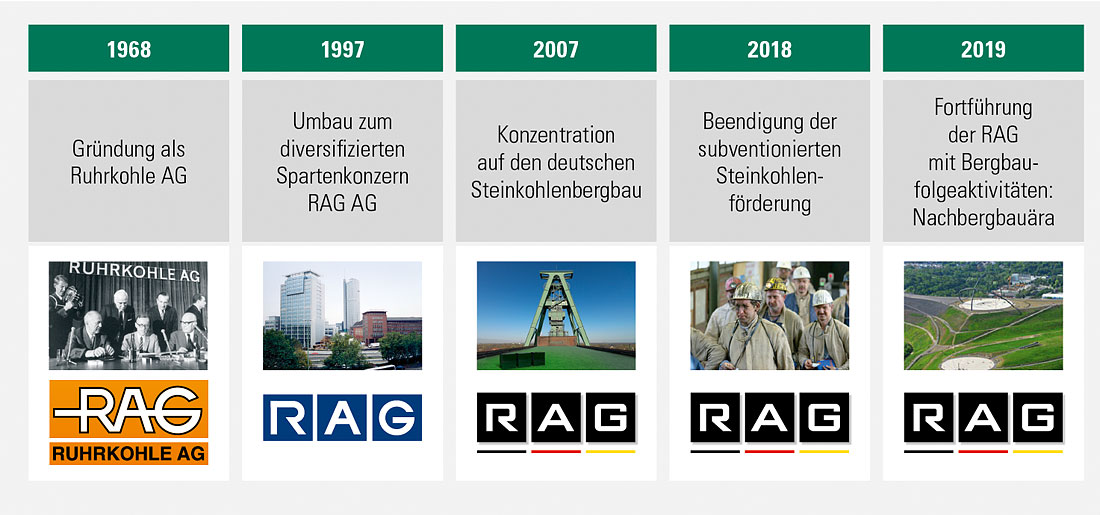
Fig. 3. Historical development of RAG and future prospects for the company in the post-mining era. // Bild 3. Historische Entwicklung der RAG und Zukunftsperspektive des Unternehmens im Nachbergbau. Source/Quelle: RAG
The Essen-based German Coal Association (GVSt), formerly known as the Association of the German Hard Coal Industry, was set up immediately after the founding of Ruhrkohle AG in 1968. The aim at that time was to place the German coal mining industry on a new footing after more than ten years of pit closures. The following years were to see all manner of negotiations, initiatives and operational measures, up to and including legislation aimed at bringing about a basic change in energy policy and contributing among other things to the complete closure of the German coal industry at the end of 2018. This paper is a synopsis of the latest Annual Report of the GVSt, which as coal production finally comes to a close in Germany attempts to look back over fifty years at what the Association managed to achieve on behalf of the nation’s mining industry.
Author: R. A. Michael Weberink, Hauptgeschäftsführer, Gesamtverband Steinkohle e. V., Essen
Read more